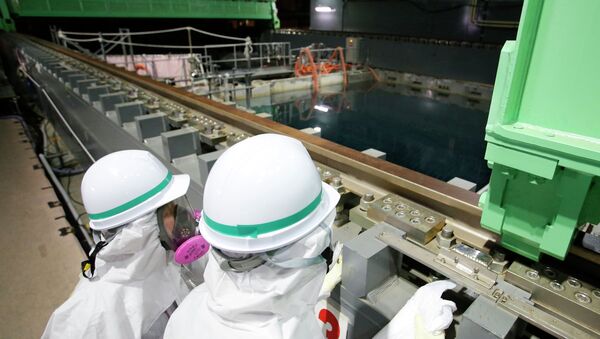MOSCOW, November 16 (Sputnik) — After more than three years spent to cleanup Japan’s tsunami-hit nuclear plant, the problem of a still-growing amount of contaminated water used to cool the damaged reactors continues to hamper the process, according to Associated Press.
Most of the workers are devoted to dealing with the contaminated water, a mixture of groundwater running into recycled water that leaks after being pumped into the reactors, according to Tatsuhiro Yamagishi, a spokesman for Tokyo Electric Power Co. (TEPCO), which owns the plant. While only a tiny group of the workers at the Fukushima Dai-ichi plant are charged with key tasks such as preparing for the dismantling of the damaged reactors and removing radioactive fuel rods.
"The contaminated water is a most pressing issue that we must tackle. There is no doubt about that," said Akira Ono, head of the plant. "Our effort to mitigate the problem is at its peak now. Though I cannot say exactly when, I hope things start getting better when the measures start taking effect."
There are hundreds of huge blue and gray tanks to house the radioactive water, and water treatment facilities are taking over the plant, where three of six reactors were melted following an earthquake and tsunami in 2011.
About 6,000 workers pass through the guarded gate of the Fukushima Dai-ichi plant every day, two to three times more than before the disaster.
The work with the contaminated water threatens to exhaust the supply of workforce for other tasks, so employees must stop working when they reach annual radiation exposure limits.
Experts say it is crucial to reduce the amount and radioactivity in the contaminated water to decrease the risk of exposure for workers and the environmental impact before the decommissioning work gets closer to the core areas.
Fukushima has six reactors, three of which were offline when the disaster hit the plant on March 11, 2011. An earthquake triggered a tsunami which knocked plant’s backup power and cooling systems and led to meltdowns at the three active reactors.
Decommissioning and dismantling of the reactors is a very delicate, time-consuming procedure. It includes removing both the melted fuel from a highly radioactive environment and additional fuel rods from the top of the reactor buildings. Multiple troubles and delay in preparatory stages have pushed back schedules of the decommissioning procedure. Recently, officials announced that the government and TEPCO plan to delay the start of fuel removal from Units 1 and 2 by about five years. The entire decommissioning process is expected to take at least 40 years.
More worrying, the flow of underground water has doubled the amount of contaminated water and spread it over large areas of the compound. The water used for cooling the reactors is exposed to radiation, and much of it pours into the basements of the turbines and reactors, and into the maintenance trenches leading to the Pacific Ocean.
Plans to freeze some of the most radioactive water inside the trench near the reactors were delayed for at least eight months due to technical difficulties. The plant reuses some of the contaminated water for cooling, but the inflow of groundwater creates a huge excess that must be pumped out. Currently, more than 500,000 tons of contaminated water is being stored in some 1,000 tanks.
An estimated $18 billion will be needed for decontamination and other mitigation of the water problem. Altogether, the decommissioning process at the plant will cost about $90 billion.
About 500 workers are preparing to build a taxpayer-funded $290 million "frozen wall" around four reactors and their turbine buildings. TEPCO is developing systems to try to remove most radioactive elements from the water. One, the Advanced Liquid Processing System (ALPS), has been trouble-plagued, but utility officials hope to achieve its daily capacity of 2,000 tons when it is fully operating next month. Officials plan to treat all contaminated water by the end of March, but it is far from certain.




